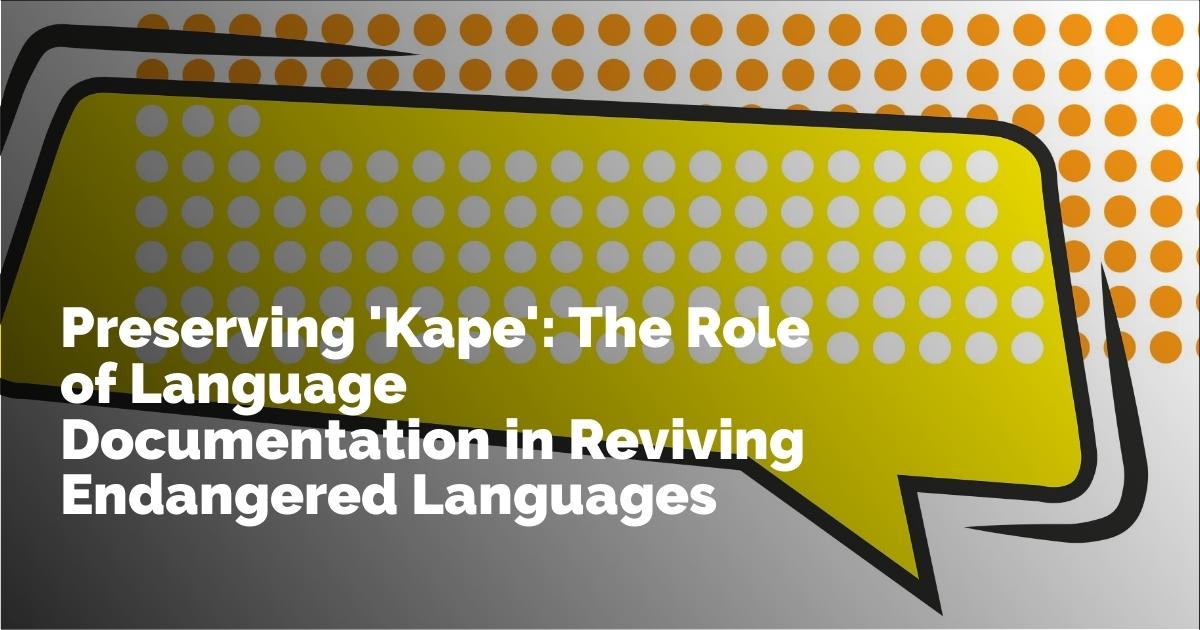Finding 'Kape': The Role of Language Documentation in Preserving Endangered Languages
In a world where over 7,000 languages are spoken, it's alarming to realize that only about half of them are adequately documented. This lack of documentation leaves the remaining languages at risk of vanishing forever. While globalization has boosted languages like English and Chinese, driving them to the forefront of global communication, numerous indigenous languages have been left behind, struggling to survive without written records.
The Threat to Indigenous Languages
Indigenous cultures, for centuries, relied heavily on oral traditions rather than written language, a factor contributing to their gradual decline. As a result, these languages are particularly vulnerable, with younger generations often shifting to widely spoken languages due to global influences and practical needs. Without concerted efforts to document and preserve them, many indigenous languages face the threat of extinction, along with the cultural heritage they encapsulate.
The Role of Language Documentarists
To counteract this loss, field linguists—or language documentarists—dedicate their efforts to recording and studying endangered languages. Their work not only records the vocabulary and grammar but also the stories, traditions, and cultural nuances embedded within these languages. This documentation is vital, ensuring that younger generations have access to their cultural roots and linguistic heritage, even if the language falls out of everyday use.
Kape: A Linguistic Discovery in Indonesia
In the face of these challenges, my research team and I have been committed to documenting endangered Papuan languages in Southeast and East Indonesia for over 13 years. Our work has focused particularly on the Alor-Pantar Archipelago near Timor and the Maluku Islands. Among our most significant recent discoveries is Kape, a previously neglected language spoken by small coastal communities in Central-Northern Alor.
Uncovering Kape
The breakthrough came in August 2024, when my research assistant, Shiyue Wu, discovered Kape while working with Abui language consultants. During her efforts to gather information about ritual altars known as "maasang" in Abui regions, she learned about "mata" in Kape—a language that had been overlooked in linguistic documentation.
Kape, intriguingly, means "rope," symbolizing the connection it provides between its speakers throughout Alor, from mountainous areas to the sea. Geographically, it is associated with Kabola in the east and Abui and Kamang in Central Alor.
Determining the Status of Kape
The linguistic status of Kape remains under investigation. While mutual intelligibility with Kamang exists, positing it as a dialect, the speakers of Kape view themselves as a distinct linguistic and ethnic group. This self-identification supports the argument for it being recognized as an independent language. Moreover, Kape shares linguistic elements with other Alor languages such as Suboo, Tiyei, and Adang.
The people who speak Kape, referred to as "Kafel" in Abui, are typically multilingual and can communicate to varying degrees in Kape, Kamang, Bahasa Indonesia, Alor Malay, and sometimes Abui. Unfortunately, no historical records of Kape have been found yet, but its age and significance are apparent through its typological and lexical features.
Challenges in Documenting Endangered Languages
Documenting languages like Kape presents ongoing challenges. The goal is to reconstruct the unwritten histories of indigenous peoples and guarantee their cultural and linguistic future. This entails preserving languages that are not just endangered but are also scarcely documented or entirely undocumented, particularly in remote and underserved areas.
Historical sources such as missionary diaries and colonial documents can sometimes offer insights into past events. However, these only provide limited linguistic data as their authors were typically not trained linguists.
Our Documentation Journey
Our team starts the documentation process by focusing on the language's lexicon and grammar, eventually delving into the traditions and ancestral knowledge of the language's speakers. We have contributed to documenting several other Papuan languages, including Abui, Kula, and Sawila, spoken among small, sometimes dispersed, indigenous communities on Alor Island.
These communities often communicate with each other in Bahasa Indonesia and Alor Malay due to the scarcity of their languages being taught in schools or used outside their immediate groups.
The Importance of Kape's Preservation
Preserving Kape is crucial not just for linguistic purposes. It signifies a means for the local community to reconnect with their history, knowledge, and traditions, ensuring these are passed down to future generations. This revitalization effort is not just about affirming Kape's existence but also about maintaining its vibrancy in the community's cultural life.
Moving Forward
The journey to document and preserve Kape is only beginning. With the collaboration of local consultants and native speakers, our team is committed to seeing this project through. Shiyue Wu, from our team, played a pivotal role in this discovery and continues to work intensively on-field to ensure the documentation and preservation of endangered languages on Alor Island.
In conclusion, finding and documenting Kape is a clear demonstration of the importance of language documentation. It not only helps preserve the language itself but also maintains the cultural heritage and identity of the people who speak it. As we move forward, the work of language documentarists becomes ever more critical in preserving the world's rich linguistic diversity for future generations.
출처 : Original Source

